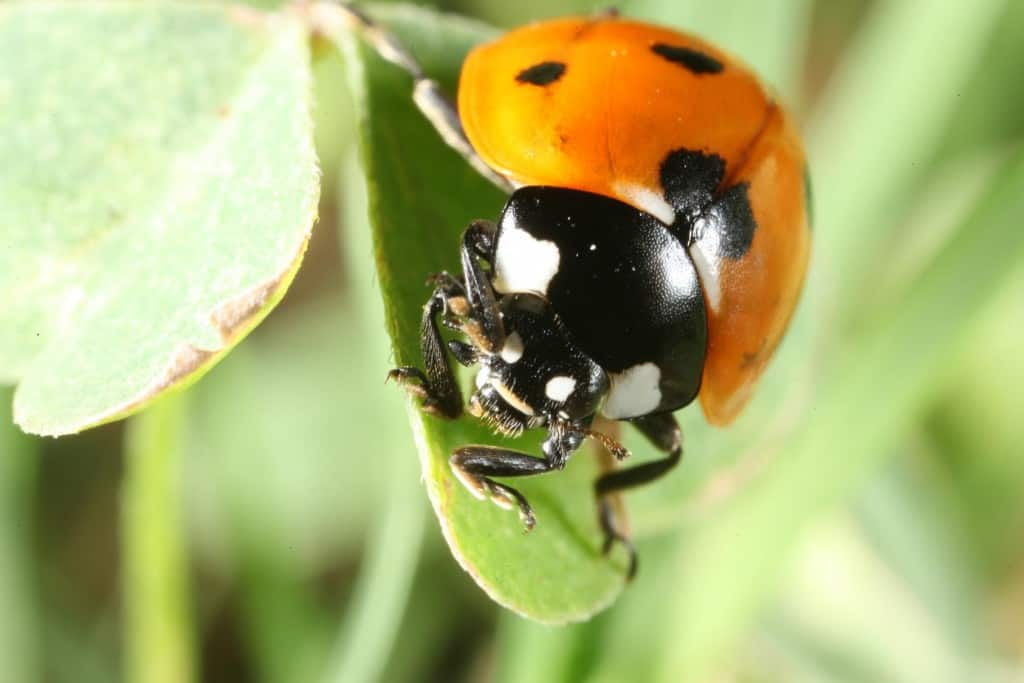No matter the environment, the brightly colored body and black spots of a ladybug make it one insect that is hard to overlook. This unique bug leads a short life filled with busy activity. Myths and folklore have swirled around it for centuries. Furthermore, the facts behind this insect are as intriguing as the ladybug itself.
A ladybug’s lifecycle falls in the range of about four to six weeks long. Certain things affect the length of a ladybug’s life such as the availability of food and the temperature of its environment. During the springtime, a ladybug lays very small yellow eggs that normally hatch in three to five days. A single ladybug can lay up to 300 hundred eggs in her lifespan! Ladybugs often lay their eggs on the underside of a leaf in an aphid colony so that the babies, or larvae, can nourish themselves on the aphids there. After three weeks or so, the six-legged larvae transform into pupa. Approximately seven days later, a fully-grown ladybug appears. Interestingly, when the ladybug does appear it may not have spots for 12 to 24 hours. Finding a ladybug like this may mean that it has just reached adulthood. In a single year, it’s not an unusual occurrence for six generations of ladybugs to come into the world. A ladybug is a truly incredible insect!
A person doesn’t have to be an entomologist (a person who studies insects) to be intrigued by ladybugs. This appealing insect continues to be worthy of our study and admiration.
To find out more about ladybugs, please visit:
- Ladybug Facts: A collection of facts on the ladybug (also known as the lady beetle) that includes information on its lifecycle as well as what it eats.
- Profile of a Ladybug: Find out about the ladybug’s environment, behaviors, and more.
- A Classroom Activity with a Ladybug Theme: Discover a group activity that will help students learn about ladybugs.
- All about Ladybugs: A fun web quest shares information about ladybugs.
- Facts on the Lives of Ladybugs: Learn significant information about the appearance and habits of ladybugs.
- Fun Ladybug Information: Peruse some basic facts about ladybugs. Also includes songs about ladybugs, fun activities, and books on this amazing insect.
- Photographs of a Ladybug: View photos of a ladybug at different stages of life.
- Illustrated Lifecycle of a Ladybug: The lifecycle of a ladybug is described in words and an illustration.
- Elements of a Ladybug: Study a labeled illustration of a ladybug.
- An Overview of the Ladybug: Learn where ladybugs live along with the insect’s common and scientific names.
- A Simple Ladybug Game: Find the right ladybugs and win this game!
- Facts and History Regarding Ladybugs: Read a selection of history concerning ladybugs that contains some folklore about the insect.
- Decorate a Ladybug: (PDF File) Decorate a ladybug in need of color and design.
- Parts of a Ladybug: Checkout an illustration of a ladybug and find out more facts about them.
- An Example of Ladybug Folklore: Discover one item of folklore regarding the ladybug.
- Web quest with a Ladybug: Learn all about ladybugs by completing this interesting web quest.
- Activities with a Ladybug Theme: Choose from a gathering of coloring activities, puzzles, and more all with a ladybug theme.
- Myths Regarding Ladybugs: Peruse a list of myths related to ladybugs.
- A Look at Ladybugs: Read all about ladybugs, their size, lifecycle, and much more!
- Anatomy of a Ladybug: Read about the different parts of a ladybug and its colors.
